Search for creative inspiration
20,009 quotes, descriptions and writing prompts, 4,967 themes

Winter - quotes and descriptions to inspire creative writing
- Autumn to winter
- cold weather
- cold winter
- condensation
- first day of winter
- mild winter
- red berries
- seasonal change
- snow clouds
- snowball fight
- warm winter
- winter landscape
- winter leaves
- winter months
- winter season
- winter storm
- winter sunset
- winter trees
- winter wonderland
- winters day
- wintry wind
Upon the leaves of evergreens, radiating in fine plume, was a pillow of white. It was as if when winter came, mother nature had tucked each one in with the finest eider-down.
To that white page of last night’s snow, no footsteps had yet to write a word. My smile grew wide as my internal hearth roared. It was mid-calf deep out there and only moon-quality strides would do. The frozen hills were hills no more, yet a playground wonderland. So before our fireside hearth, warm cocoa in hand, we planned a day of merriment.
Winter comes as a hearth song bequeathed by black cradled stars.
Winter arrives, an icy serenade, a coolness to bring out the warmth within.
The winter sun brought out the purity of the heaven-given snow, as if were a blank page for our merriment, inviting the feet to play and the spirit to laugh.
This winter I'm gonna win. Let the ice crackle underfoot, for it is nothing as compared to this warm heart and the fire burning within, that steady pilot flame. That's the thing about these tough times, the most loving win because we dig in, we get determined when the greedy cut and run. So, that winter wind with its toothy bite is nothing but excitement to me.
The winter is such crystalline joy, those brilliant rays that show the uniqueness of every snowflake. It is the time of puddles that become transient skating rinks and for my thoughts to remain cozy within a woollen hat. It is the time when the sunniest of days are warm even in when I can see my breath rise as neat and pure vapour. It is the days of quiet poetry forming in my soul as if it calls to the spring flowers that will soon blossom.
The wintry sun is the brightness of the day, taking centre stage as the blooms of the summertime become a part of the soil. The sunshine and cold, the sparkle and the ice, somehow warm even when the north wind bites. There will be days I wish to stay in the warm, to observe from a duvet, fingers wrapped snuggly around some cocoa... yet somedays the winter takes my hand and shows me its beauty, that in truth, it is but the dawn of spring.
The river appears still, yet she flows under the thinnest of ice, awaiting the gentle touch of the sun. Though the air bares only the coldness and the ground is frozen once more, they glitter with the gift of each nascent ray. It is as if God ensured there would be hope even on the deepest and most wintry of days, asking us to see the sparks that remain even when the world is frozen. And so I choose not to see the blanket of ice but the waters that remain deep and moving, ever onward to join the ocean in its slow yet sure way.
Wintry trees stand as ballet dancers poised to show the world their grace, strength showing in how they remain so still in the seasonal gusts. Now that the leaves have fallen, they are so proud, as if their silvery-brown skin was their glory all along. I lift my head into the wind, eyes open for this softly lit day. Cold is good if you are warm inside, just the same as we love ice in the summer time.
Before the cold winds come to breathe our world anew, before snow makes our familiar streets a canvas for dreams, I see each sculpted flake with eyes at rest, the chaotic dance of billions uniting over the earth. These daydreams are my hearth-fire, bringing the hint of a newborn smile, one that lifts every part of what I am. I ask the icy wind to bring me to higher senses, to wake within that which rested in the easy summer days; for in these dreams are wintry puddles, silver-blue in the path, as if they were nascent moons born to shine. Then, as if I can contain this energy surge no-longer, I run... I run past trees with skin the hue of spring soil, through shadow and light just the same.
Upon each tree born wand, naked from winter's rasp, come the buds of spring. Each tells of green leaves to come, or the sweet blossom within. Even as cold winds blow, they are such embryonic joy.
As the long summer days linger in our memories, nature rests her rainbow palette. In their place she brings out the colours of beach and woodland, soothing us into a quiet reflection. We walk through pictures shown so beautifully by the winter sun; each as bathed in love as the one before. Be it the blue of sea or sky, or every shade of brown from almost white to almost black, it brings a peaceful harmony. Yet in this choir of colours, mother nature keeps by a little green, a little red, for the holly tree, the evergreens and robins. And after this rest, this deep breath of cool fresh air, we are ready for the sweet mischief of spring.
Under a dove grey sky the colours of my world don their winter coats, each hue darker and richer than before. The path sparkles and crunches, like sugar underfoot, and the coolness brings me right into the now, into the moment of life. Though the flowers sleep and the trees show their lofty arms once more, a smile plays upon these cold lips. For as much as I love the summertime, I love the winter too. For every perfume of the meadow, there is the earthy loam of the newly-lit forest floor.
There is a warmth that tumbles out in the winter time; when all else is so cold. It radiates from those who love and nurture as easily as they breathe. In truth, the sparks of warmth are always there no matter the season, just like a warm rock blends into a summer beach, yet melts winter ice.
The air is frozen lace on my skin, delicate and cold, like winter waves on sallow sand. The sky is washed with grey, watery light illuminating thin patches to brilliance. In some moments I am watching my boots over the frozen sidewalk, perfect concrete slabs, flat and square, and in others transfixed to the interplay of cloud and sun above. For some reason my mind conjures a stone mosaic made beautiful by the shards of a mirror and I want to keep my eyes heaven bound while my imagination makes them one thing. Only the slipping of my feet brings my attention earthward once more, the need to stay upright pulling my mind into the present.
The rain has lost the ambient temperature of early fall, freezing and paling my skin on contact. The path through the park is muddy water in motion, filling deep puddles that hide the ruts of dryer weather. To feel it isn't enjoyment, not fun like the gentle sunshine of springtime, yet it is a part of life and I want to feel it just the same. I want to experience each drop, together and apart, same and different. I want to see the droplets soaking my eyelashes before they join their brethren on the ground like saltless tears. I need to be in this, chaotic and wild, just like my mind and soul - like nature looked right into me and pulled the weather out.
Though the winter had been long, the first signs of spring grew boldly, as if commanding the warm weather to come all the faster. It was as if the teeth of winter had shattered and the kiss of a new season approached. Joanna breathed in deeply, so wanting the pretty flowers and blossoms that she could almost smell the promise of their fragrance. Just to imagine the change of season relaxed her and she walked down the wide avenue with her favourite, her steps bolder than they had ever been before.
Even on the coldest days of winter the sun is bright in the sky, bringing joy to my heart. The snow has a purity that elevates my spirit, the world made as pristine as a book ready for new stories. Already my creativity is surging, dancing around the evergreens with the delight of a child. Even the coldness upon my face is refreshing, my body cozy inside a warm coat.
Under the wintry air and the sky that has born black clouds since November came, the harbour is as grey as a newspaper picture. The sea has given up her blue, the stones show no russet colours and the boats have taken on the monochrome look of old movies. Even the air tastes more dull. The wind whips salt into eyelashes and onto exposed skin and all the while the trams run along the beachside with a clatter and whir.
For years I had lived winter and summer in separate houses, believing them to be both necessary to my wellbeing. Yet truly, my heart was in my summer house and this time, when winter called, I refused with a simple shake of my head. The months rolled by regardless and snow did fall on my summer house. In my tall boots I strode out to meet the world made anew and clapped my hands for joy, for the sight of the home I only associated with the warm weather was prettier than my imagination had ever conjured before. That year new life was breathed into my bones and I chose my summer home to be my only one.
The naked winter trees line the avenue. Our breath rises in visible puffs to join the darkened clouded night sky. There is a freezing chill in the air that brings crispness to the leaves, bejewelled with frost, that crunch underfoot. Rosy cheeked, we stamp to keep warm, pulling woollen hats over our reddened ears and tightening scarves over our blue-tinged lips. Teeth chatter and the cold seeps into our gloves numbing our fingers until they cease to bend properly, stiffened and frigid. Suddenly the illuminated sign on the bus appears, trundling slowly down the icy black road and we raise our arms to hail it.
The snow comes, white and glistening, erasing the troubles beneath, directing me toward a new and positive day. The coldness only crispens up my resolve to find love today. Perhaps in this swirling perfect whiteness that gives crystalline kisses, the coolness in the air will rejuvenate my soul, elevate my spirit and give me new reasons to step forward with confidence. It might be winter but there is beauty in it, clarity, the kind of thinking that lets me notice small details like how the trees though bare have the promise of spring within them, like the creator Himself lies dormant in the branches, ready to burst forth and greet the world with His many hues of green.
Mama always made her home-made soups and stews on those crisp winter days. The stew would warm us down to our toes, radiating the kind of glow that only her hearty food could give.
Sign in or sign up for Descriptionar i
Sign up for descriptionar i, recover your descriptionar i password.
Keep track of your favorite writers on Descriptionari
We won't spam your account. Set your permissions during sign up or at any time afterward.
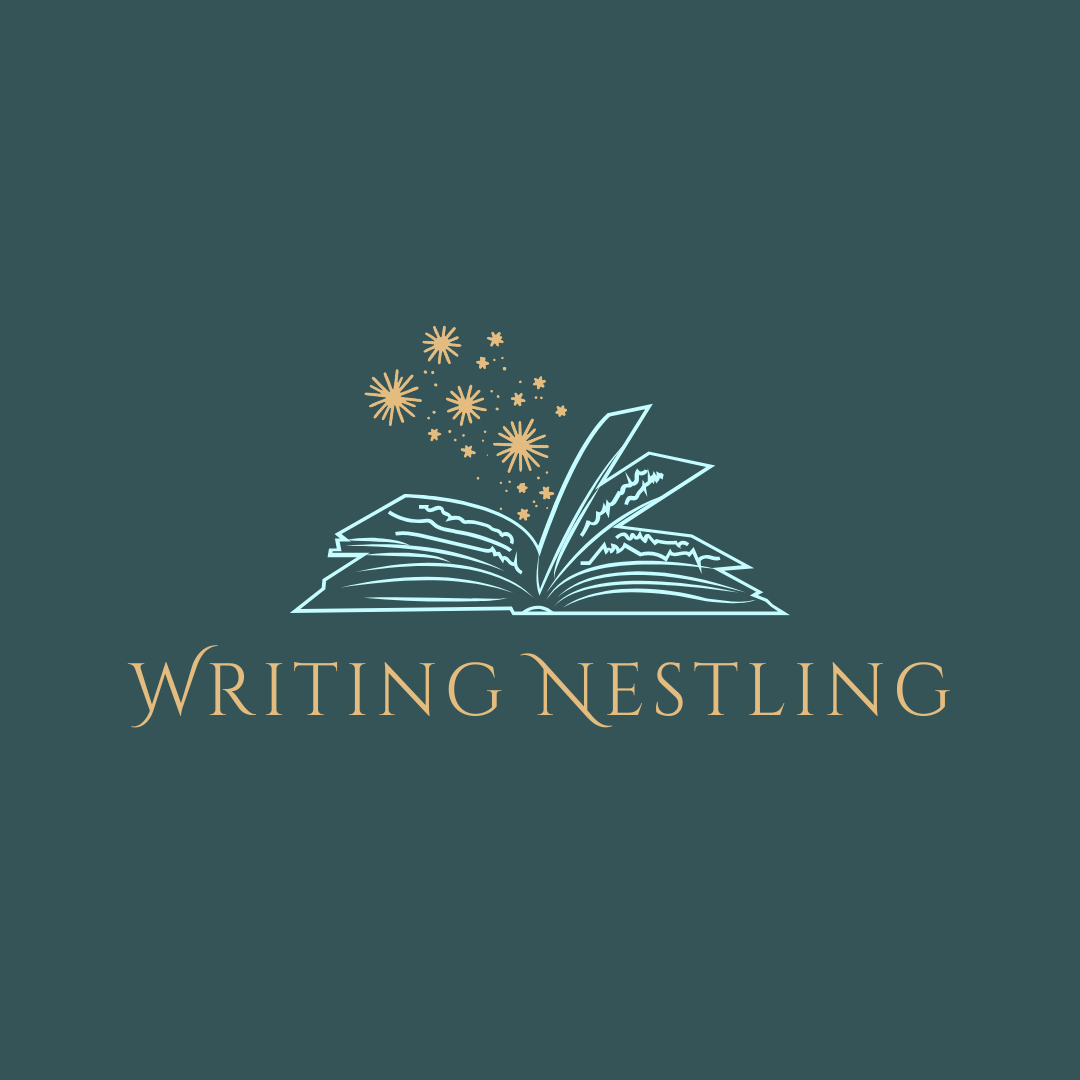
Writing Nestling
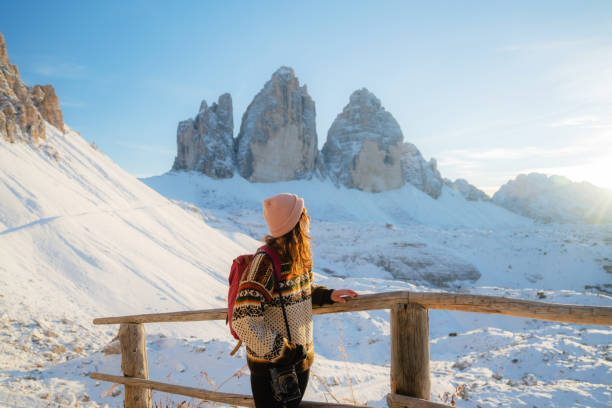
How To Describe Winter Season In Writing (12 Best Ways, Adjectives& Quotes)
Table of Contents
How To Describe Winter Season In Writing
How To Describe Winter Season In Writing: Describing the winter season in writing is an enchanting endeavor that allows words to transcend the boundaries of language and immerse the reader in a world of frosty wonder.
Winter’s crystalline landscapes, snow-laden boughs, and icy breath create a canvas upon which authors paint with vivid imagery and sensory details.
It’s a season of contrasts—of stark beauty and harsh conditions, introspection and celebration, solitude and togetherness.
In this exploration of how to encapsulate the essence of winter through words, we embark on a journey to capture the season’s profound impact on the natural world, human emotions, and daily life.
Join us as we delve into the art of storytelling amidst the snowflakes and chill, discovering the power of language to transport readers to the heart of winter’s enchantment.
Describing the winter season in writing involves creating a vivid and sensory-rich portrayal of this time of year. Here’s a step-by-step process on How To Describe Winter Season In Writing:
Observation and Note-taking
Start by observing the winter environment. Take notes on what you see, hear, smell, taste, and feel during this season. Pay attention to the landscapes, weather, and activities associated with winter.
Setting the Scene
Begin your description by setting the scene. Describe the location and time of day. For example, “In the heart of a snow-covered forest on a crisp winter morning…”
Weather and Temperature
Mention the weather conditions. Is it snowing, sleeting, or just cold and clear? Use sensory words to convey the temperature, such as “biting cold” or “frosty.”
Landscape and Nature
Describe the natural elements. Mention the snow-covered trees, frozen lakes, icicles hanging from rooftops, or the crunch of snow beneath your feet. Use descriptive language to paint a picture of the winter landscape.
Sounds of Winter
Include the sounds of winter. Describe the quiet hush of falling snow, the crunch of boots on a snow-covered path, or the distant laughter of children playing in the snow.
Activities and Traditions
Write about the activities and traditions associated with winter. Mention sledding, building snowmen, ice skating, or holiday celebrations. Describe how people dress warmly and gather around the fire.
Sensory Details
Engage the reader’s senses. Use descriptive language to evoke the feeling of cold air on the skin, the taste of hot cocoa or spiced cider, the scent of pine trees, or the sight of twinkling holiday lights.
Emotions and Moods
Explore the emotions and moods that winter evokes. Talk about the coziness of being bundled up indoors, the sense of wonder as snow falls, or the nostalgia of the holiday season.
Metaphors and Similes
Consider using metaphors and similes to make your description more vivid. For example, “The snow-covered landscape was like a blank canvas waiting for the artist’s touch.”
Transitions and Flow
Ensure a smooth flow in your writing. Use transition words and phrases to connect your descriptions, so the reader can move seamlessly from one aspect of winter to another.
Editing and Polishing
Review and revise your writing for clarity, coherence, and conciseness. Eliminate unnecessary words and ensure your descriptions are engaging.
Wrap up your description by summarizing the essence of the winter season. Leave the reader with a lasting impression of what makes winter special or unique.
By following these steps, you can effectively describe the winter season in your writing , bringing it to life for your readers.

Adjectives Or Words To Describe Winter
Crisp: Winter air often feels crisp, with a sharp and refreshing quality that invigorates the senses. The cold temperatures contribute to this characteristic, creating a clear and clean atmosphere.
Frosty: Winter landscapes can be described as frosty, with a delicate layer of frozen dew or ice crystals covering surfaces, giving them a sparkling and magical appearance.
Snowy: One of the defining features of winter is the presence of snow. A snowy scene evokes a sense of purity and tranquility, transforming the environment into a soft, white wonderland.
Cozy: Winter is synonymous with cozy moments spent indoors by a warm fire, wrapped in blankets, and enjoying the comfort of home. This adjective captures the feeling of warmth and contentment during the colder months.
Serene: Winter landscapes often exude a sense of serenity, with quiet snow-covered surroundings and a calm stillness that can be both peaceful and contemplative.
Invigorating: The brisk, cold air of winter can be invigorating, awakening the senses and providing a refreshing contrast to the warmth of indoor spaces.
Whimsical: Winter can have a whimsical quality, especially when snowflakes fall gently, creating a dreamlike and enchanting atmosphere that feels almost magical.
Glistening: The sunlight reflecting off the snow and ice can make winter landscapes glisten, adding a touch of brilliance and sparkle to the scenery.
Majestic: Winter’s landscapes, with snow-covered trees and frost-laden branches, often evoke a sense of majesty and grandeur, transforming ordinary scenes into something extraordinary.
Enchanting: Winter possesses an enchanting quality, with its frosty beauty and the hushed stillness of snow-covered landscapes, captivating observers and creating a sense of wonder.
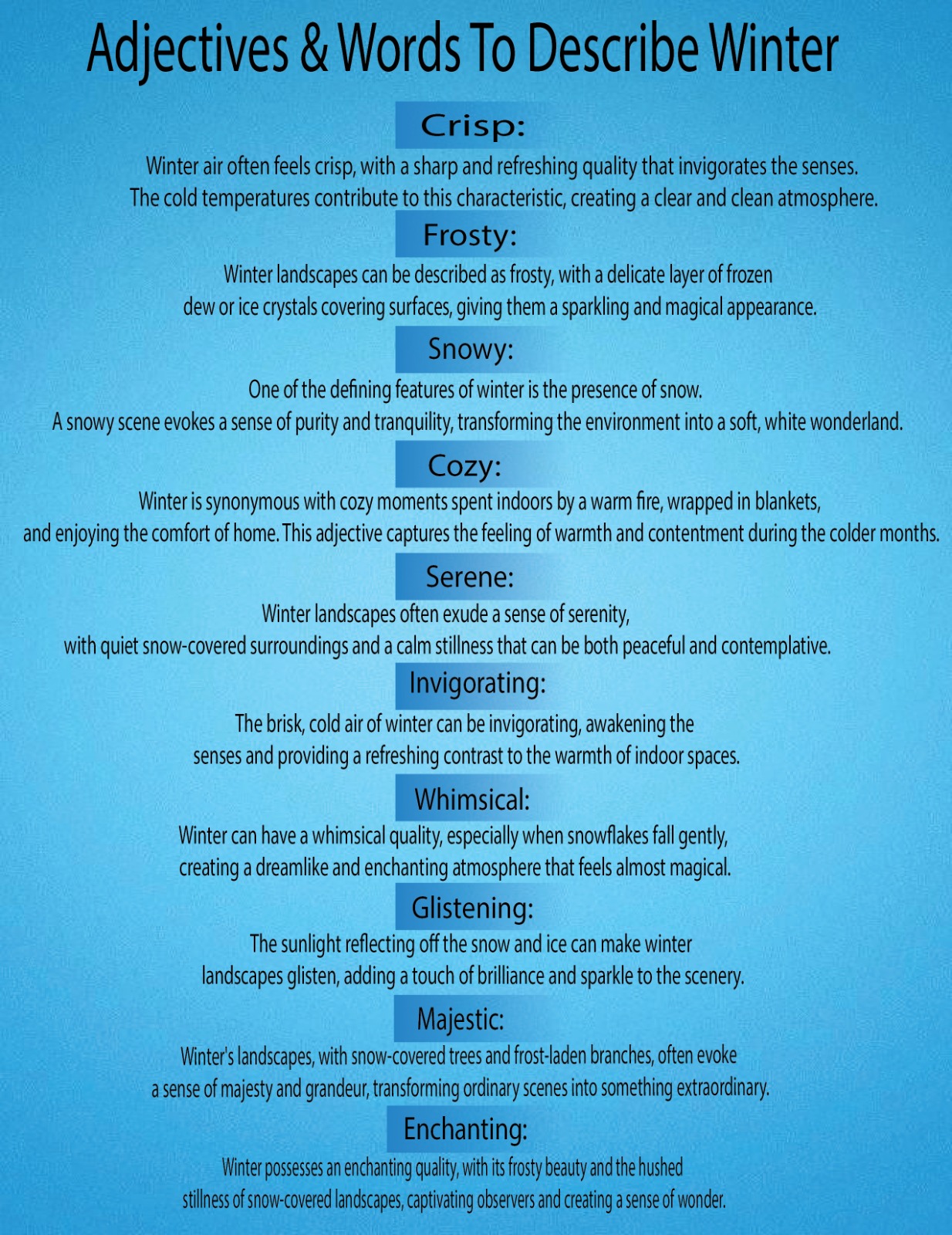
Quotes About Winter Season
Here are a few quotations about the winter season, along with references:
“Winter is the time for comfort, for good food and warmth, for the touch of a friendly hand and for a talk beside the fire: it is the time for home.” (Edith Sitwell)
“Winter is the time of promise because there is so little to do – or because you can now and then permit yourself the luxury of thinking so.” (Stanley Crawford)
“A snow day literally and figuratively falls from the sky—unbidden—and seems like a thing of wonder.” (Susan Orlean)
“Winter, a lingering season, is a time to gather golden moments, embark upon a sentimental journey, and enjoy every idle hour.” (John Boswell)
“In the depth of winter, I finally learned that within me there lay an invincible summer.” (Albert Camus)
Creating a Winter Wonderland
Creating a winter wonderland is like painting with nature’s own brush, a masterpiece forged from frost and magic.
As you step into this crystalline realm, the world transforms into a shimmering paradise. Each flake of snow, like a unique work of art, adorns the landscape with intricate designs.
The air is electric with the promise of quiet miracles, and every tree stands as a sentinel wrapped in glistening crystal armor.
Here, the world becomes a hushed symphony of nature’s whispers, inviting you to explore the enchantment hidden within the icy tapestry.
The power of sensory details
The power of sensory details lies in their ability to breathe life into words, transforming a mere description into a vivid and immersive experience for the reader.
When you evoke the senses of sight, sound, touch, smell, and taste in your writing, you engage the reader on a profound level.
With the stroke of a pen or the typing of keys, you can make them see the snow-capped mountains, hear the melodic chirping of birds, feel the cool breeze on their skin, catch the aroma of blooming flowers, or even taste the bittersweet nostalgia of a childhood memory.
These sensory elements not only enrich the narrative but also create an emotional connection, making the reader not just a passive observer but an active participant in the world you’ve crafted.
In the hands of a skilled writer, sensory details have the power to transcend words, leaving an indelible impression on the reader’s imagination.
Describing winter’s effect on the environment
Winter casts its enchanting spell upon the environment, turning the world into a breathtaking tableau of transformation.
As temperatures plummet and the first snowflakes descend, a serene hush blankets the land. Bodies of water, once teeming with life, now lie beneath a crystalline veneer, their surfaces frozen in stillness.
Windows become canvases for delicate frost patterns, resembling nature’s own intricate artwork. Architecture, too, undergoes a metamorphosis, with rooftops and branches heavy with snow, bending under its weight.
It’s a season of quiet marvels and serene beauty, where the environment, like a patient artist, surrenders to the gentle touch of winter, creating a surreal landscape where each element wears the cloak of frost and serenity.
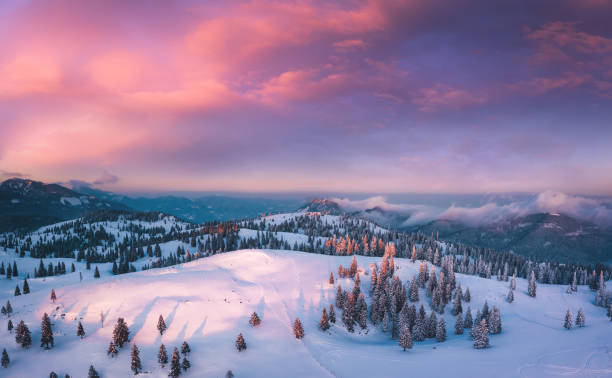
Evoking Emotions and Atmosphere
Emotions are the symphony, and atmosphere the conductor in the grand opera of storytelling.
Just as a maestro’s baton commands the rise and fall of a musical masterpiece, a skilled writer wields their words to evoke emotions and shape the atmosphere within their narrative.
In the realm of words, we can craft a storm of heartache that drenches the reader with empathy or a sunbeam of joy that warms their very soul.
Through masterful storytelling, we can transport readers to the darkened alleyways of fear or the sunlit gardens of love.
Every paragraph becomes an enchanting melody that resonates in the reader’s heart, every word, a brushstroke on the canvas of their imagination.
To paint the palette of emotions and atmosphere is to awaken the dormant spirits within a story, inviting the reader to dance with the characters, breathe the air of foreign lands, and feel the tremors of emotions that pulse with life.
Winter as a time of introspection
Winter serves as an introspective cocoon, where the world retreats into a silent slumber, and our thoughts unfurl like dormant buds waiting for the warmth of spring.
The snow blankets the land in a quiet serenity, creating an almost otherworldly stillness. In these frozen moments, we find solace in self-reflection, as the bare trees and the chill in the air reflect the stripped-down simplicity of our own thoughts.
The world seems to whisper secrets, inviting us to delve into the depths of our inner landscapes. It’s a time when the crackling of a fireplace becomes an accompaniment to our inner musings, and the solitude of the snow-covered landscape mirrors the silent chambers of our hearts.
Winter, in all its stark beauty, is a sanctuary for introspection, a season that beckons us to delve into the frosty recesses of our souls, seeking clarity and renewal.
The feeling of nostalgia
Nostalgia is a bittersweet embrace of the past, a melody that tugs at the heartstrings, often catching us by surprise.
It’s the scent of an old, worn book, the familiar taste of a childhood dish, or the sepia-toned memories of yesteryears.
Nostalgia is a window into the cherished moments and the places we’ve left behind. It transports us to a time when life seemed simpler, or perhaps when we were different people altogether.
It’s a feeling that brings both comfort and a longing ache, like a familiar face in an old photograph, simultaneously grounding us in the past and reminding us of the inexorable march of time.
Nostalgia has the power to make the ordinary extraordinary, for within its embrace, even the most mundane memories become precious, like shards of a shattered mirror that reflect our lives, refracted through the lens of memory.
Weathering the Elements
Weathering the elements is a courageous dance with nature’s most formidable partners, where humanity and the environment engage in an intricate tango of resilience and adaptability.
The elements of wind, rain, snow, and sun become our tempestuous partners, each challenging us to find our balance on the ever-shifting stage of life.
The thrill of a thunderstorm, the serenity of a gentle snowfall, the relentless force of a hurricane—all these natural phenomena are a testament to the awe-inspiring power of the elements.
As we navigate their capricious moods, we discover our own tenacity, drawing strength from the tempests that test our mettle.
In weathering the elements, we become not just observers of nature’s grand performance, but participants in the ongoing drama of survival, resilience, and the enduring human spirit.
The dramatic tension of winter storms
Winter storms are nature’s grand theater productions, where the stage is set with an icy backdrop, and the players are wind, snow, and the restless sky.
There’s a palpable dramatic tension that builds as dark clouds gather, and the air grows heavy with anticipation.
As the first snowflakes descend, it’s as if the opening act has begun, a delicate overture that soon crescendos into a tempestuous symphony of howling winds and swirling snow. Each snowflake is a character in this epic narrative, vying for its place in the swirling plot.
The world becomes a hushed audience, witnessing the turmoil and the magnificence of a winter storm with bated breath.
Amid this turbulent performance, there’s an undeniable exhilaration, a thrilling sense of nature’s raw power and the fragility of our human existence.
Winter storms are both a spectacle and a reminder of the forces that shape our world, a captivating drama that leaves us in awe of the beauty and chaos of the natural world.
Human interaction with winter
Human interaction with winter is a remarkable tapestry of adaptation and celebration, a testament to our indomitable spirit.
In the face of biting cold and relentless snowfall, we don our warmest attire and venture into the frosty embrace of this season.
From the laughter of children building snowmen to the grace of ice skaters on frozen ponds, we seize the opportunity to revel in the unique activities that winter bestows upon us.
Yet, this interaction also bears the weight of responsibility, as we navigate treacherous roads and prepare for the challenges of snow removal.
Winter is a season that demands both reverence and resilience, where the human spirit shines brightly, illuminating the darkest days with our resourcefulness, creativity, and the warmth of community.

The impact of winter on daily life
The impact of winter on daily life is an intricate interplay of challenge and charm, where the world outside transforms into a breathtaking wonderland while our routines undergo adjustments.
The shorter days and longer nights compel us to adapt, embracing the cozy sanctuary of home and the warmth of shared moments with loved ones.
From the practicality of shoveling driveways and navigating icy streets to the joy of curling up by the fireplace with a good book, winter’s influence weaves its way into every facet of our existence.
It calls for extra layers, hot beverages, and the soothing embrace of comfort food.
In these chilly months, we become both the beneficiaries of nature’s artistry and the architects of our own winter stories, each day a new page to be written in the diary of a season where the world slows down, offering us a chance to savor life’s simpler pleasures.
Frequently Asked Questions (FAQ) about How To Describe Winter Season In Writing
What is the best way to start a description of the winter season in writing.
Begin by setting the scene. Describe the location and time of day, creating a clear and vivid starting point for your readers.
How can I effectively convey the weather and temperature of winter in my writing?
Use descriptive language to depict the weather conditions and temperature. Words like “snowy,” “icy,” “chilly,” and “freezing” can help paint a clear picture.
What are some key elements of the winter landscape to include in my description?
Mention snow-covered trees, frozen bodies of water, icicles hanging from surfaces, and any other distinctive features of the winter environment in your description.
How can I make my writing about winter more sensory-rich?
Engage the reader’s senses by describing what can be seen, heard, felt, smelled, and even tasted during the winter season. Mention the sounds of snowfall, the feeling of cold air, the scent of evergreen trees, and the taste of seasonal treats.
What emotions and moods should I explore when writing about winter?
Delve into emotions like coziness, wonder, nostalgia, or even the sense of isolation that winter can bring. These emotions can help create a more well-rounded description.
Should I use metaphors and similes when describing winter?
Metaphors and similes can be powerful tools to make your descriptions more vivid. For example, you could liken a snowy landscape to a pristine canvas or a white blanket.
How do I maintain a smooth flow when describing the winter season in writing?
Use transition words and phrases to connect different aspects of your description. This will ensure that your writing flows smoothly from one detail to the next.

What is the best way to conclude a description of the winter season?
In your conclusion, summarize the essence of the winter season and leave the reader with a lasting impression of what makes winter special or unique.
How can I make my description of winter stand out and feel unique?
Focus on the distinctive elements of winter that resonate with you. Highlight what sets this season apart in your eyes, whether it’s the serenity of falling snow or the festive spirit of the holidays.
Any tips for editing and polishing my winter descriptions?
After writing, carefully review your work for clarity, coherence, and conciseness. Eliminate unnecessary words and ensure your descriptions are engaging and captivating for your audience.
In the conclusion of How To Describe Winter Season In Writing, the winter season serves as a remarkable thread, weaving its unique charm into the fabric of storytelling.
As we conclude this exploration of how to describe winter in writing, we are reminded of the enduring power of words to evoke the beauty, complexity, and emotions of this enchanting season.
Through vivid imagery, sensory details, and the exploration of winter’s impact on both the environment and the human experience, we have glimpsed the magic of this time of year.
The icy landscapes, cozy firesides, and moments of introspection have been laid bare through the art of the written word, inviting readers to partake in the wonders of winter.
In the hands of a skilled writer, winter becomes more than just a season—it becomes a canvas upon which stories are painted with the brushstrokes of imagination, where the snowflakes themselves whisper secrets and the chill in the air holds untold mysteries.
The ability to describe winter in writing is a precious gift, allowing us to share the enchantment of this season with the world and to celebrate its enduring allure.
Related Posts:
- How to Describe Spring Season in Writing (08 Best Tips)
- How To Describe Autumn Season In Writing (11 Steps,…
- How To Describe Being Cold In Writing (11 Best Ways)
- How To Describe A Forest In A Story (For Beginners In 2024)
- How To Describe Summer Season In Writing (08 Best Steps)
- How To Describe A River In Writing (10 Best Ways)
Similar Posts

How To Describe A Car In Writing (For Beginners In 2024)
How To Describe A Car In Writing How To Describe A Car In Writing: In the realm of automotive eloquence, the art of describing a car in writing transcends mere technicalities; it’s a literary voyage that invites readers to feel the hum of an engine, witness the gleam of a polished chassis, and embark on…

How to Write a Mystery Thriller Novel (10 Best Tips)
How to Write a Mystery Thriller Novel Writing a mystery thriller is like creating a puzzle that keeps readers curious and turning the pages to find out what’s going on. If you’ve ever been engrossed in a narrative that kept you on the edge of your seat, you understand the power of a good mystery…
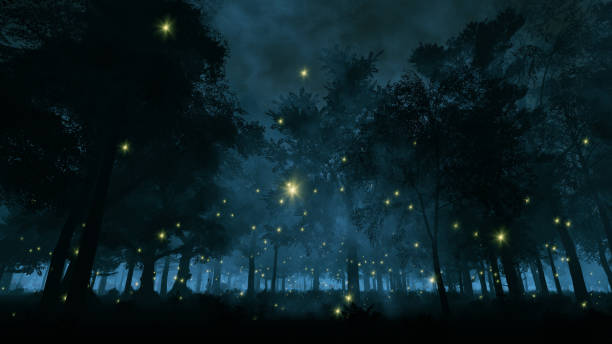
How to Describe a Magical Forest (10 Effective Tips)
How to Describe a Magical Forest How to Describe a Magical Forest: Describing a magical forest is akin to navigating the labyrinthine corridors of imagination, where the ordinary yields to the extraordinary, and reality dances in harmony with fantasy. Within the emerald embrace of ancient trees and beneath the celestial canopy, a magical forest unfolds…

How to Write a Novel With Multiple Protagonists In 2024
How to Write a Novel With Multiple Protagonists How to Write a Novel With Multiple Protagonists: Embarking on the journey of crafting a novel with multiple protagonists is a literary adventure that opens doors to a multifaceted narrative universe. In this realm, characters don’t merely inhabit the story; they coalesce into a dynamic ensemble, each…

10 Best Ways To Describe Running In Writing
Ways To Describe Running In Writing Ways To Describe Running In Writing: In the intricate dance between pen and pavement, the art of describing running in writing transcends mere physical motion, becoming a literary expedition that explores the depths of human experience. Just as each runner leaves an indelible imprint on the terrain they traverse,…

How To Write An Editorial (A Guide For Beginners- 2024)
How To Write An Editorial How To Write An Editorial: Embarking on the journey of crafting an editorial is akin to stepping into the arena of persuasive prowess, where words transform into instruments of influence and ideas wield the power to shape perspectives. Writing an editorial is not merely an exercise in expression; it is…
- Craft and Criticism
- Fiction and Poetry
- News and Culture
- Lit Hub Radio
- Reading Lists

- Literary Criticism
- Craft and Advice
- In Conversation
- On Translation
- Short Story
- From the Novel
- Bookstores and Libraries
- Film and TV
- Art and Photography
- Freeman’s
- The Virtual Book Channel
- The Lit Hub Podcast
- The Critic and Her Publics
- Fiction/Non/Fiction
- I’m a Writer But
- Windham-Campbell Prizes Podcast
- Write-minded
- First Draft: A Dialogue on Writing
- Behind the Mic
- Lit Century
- Tor Presents: Voyage Into Genre
- Beyond the Page
- The Cosmic Library
- Emergence Magazine
- The History of Literature
- The Best of the Decade
- Best Reviewed Books
- BookMarks Daily Giveaway
- The Daily Thrill
- CrimeReads Daily Giveaway
News, Notes, Talk

Let it snow: 6 of the best descriptions of winter weather in literature.

Oh, the weather outside is frightful! But the reading is so delightful… Weather (sorry) or not you love the snow—blanketing your driveway, stalling your subway lines—it’s hard to deny that there have been some pretty darn good descriptions of it in literature, the kind that make you want to curl up by the fire (or, in my case, the space heater). Personally, I think I like winter weather best when it’s on the page and not the thing standing between me and the closest bar or the corner bodega when I’m out of popcorn. In an attempt to reframe the cold months ahead for myself, I have assembled some of the most beautiful/relatable descriptions of snow I could find in fiction. Perhaps now I will think of it as one of these instead of being irrationally irritated by Mother Nature’s cruel attempts to curb my snacking and my social life. So, here we go: let it snow! Sit down with these delightfully icy passages, and keep the hot cocoa coming.
From Leo Tolstoy’s Anna Karenina :
At first she was unable to read. To begin with she was bothered by the bustle and movement; then, when the train started moving, she could not help listening to the noises; then the snow that beat against the left-hand window and stuck to the glass, and the sight of the conductor passing by, all bundled up and covered with snow on one side, and the talk about the terrible blizzard outside, distracted her attention. Further on it was all the same; the same jolting and knocking, the same snow on the window, the same quick transitions from steaming heat to cold and back to heat, the same flashing of the same faces in the semi-darkness, and the same voices, and Anna began to read and understand what she was reading.
From Italo Calvino’s If on a winter’s night a traveler :
So here I am walking along this empty surface that is the world. There is a wind grazing the ground, dragging with flurries of fine snow the last residue of the vanished world: a bunch of ripe grapes which seems just picked from the vine, an infant’s woolen bootee, a well-oiled hinge, a page that seems torn from a novel written in Spanish, with a woman’s name: Amaranta. Was it a few seconds ago that everything ceased to exist, or many centuries? I’ve already lost any sense of time.
From Ali Smith’s Winter :
And here instead’s another version of what was happening that morning, as if from a novel in which Sophia is the kind of character she’d choose to be, prefer to be, a character in a much more classic sort of story, perfectly honed and comforting, about how sombre yet bright the major-symphony of winter is and how beautiful everything looks under a high frost, how every grassblade is enhanced and silvered into individual beauty by it, how even the dull tarmac of the roads, the paving under our feet, shines when the weather’s been cold enough and how something at the heart of us, at the heart of all our cold and frozen states, melts when we encounter a time of peace on earth, goodwill to all men; a story in which there is no room for severed heads; a work in which Sophia’s perfectly honed minor-symphony modesty and narrative decorum complement the story she’s in with the right kind of quiet wisdom-from-experience ageing-female status, making it a story that’s thoughtful, dignified, conventional in structure thank God, the kind of quality literary fiction where the slow drift of snow across the landscape is merciful, has a perfect muffling decorum of its own, snow falling to whiten, soften, blur and prettify even further a landscape where there are no heads divided from bodies hanging around in the air or anywhere, either new ones, from new atrocities or murders or terrorisms, or old ones, left over from old historic atrocities and murders and terrorisms and bequeathed to the future as if in old French Revolution baskets, their wickerwork brown with the old dried blood, placed on the doorsteps of the neat and central-heating-interactive houses of now with notes tied to the handles saying please look after this head thank you […]
From Donna Tartt’s The Secret History :
The snow in the mountains was melting and Bunny had been dead for several weeks before we came to understand the gravity of our situation.
From Kelly Link’s Stranger Things Happen :
The next day it was snowing and he went out for a pack of cigarettes and never came back. You sat on the patio drinking something warm and alcoholic, with nutmeg in it, and the snow fell on your shoulders. You were wearing a short-sleeved T-shirt; you were pretending that you weren’t cold, and that your lover would be back soon. You put your finger on the ground and then stuck it in your mouth. The snow looked like sugar, but it tasted like nothing at all.
From Charles Dickens’ A Christmas Carol :
Holly, mistletoe, red berries, ivy, turkeys, geese, game, poultry, brawn, meat, pigs, sausages, oysters, pies, puddings, fruit, and punch, all vanished instantly. So did the room, the fire, the ruddy glow, the hour of night, and they stood in the city streets on Christmas morning where (for the weather was severe) the people made a rough, but brisk and not unpleasant kind of music, in scraping the snow from the pavement in front of their dwellings, and from the tops of their houses, whence it was mad delight to the boys to see it come plumping down into the road below, and splitting into artificial little snow-storms.
The house fronts looked black enough, and the windows blacker, contrasting with the smooth white sheet of snow upon the roofs, and with the dirtier snow upon the ground; which last deposit had been ploughed up in deep furrows by the heavy wheels of carts and wagons; furrows that crossed and re-crossed each other hundreds of times where the great streets branched off; and made intricate channels, hard to trace, in the thick yellow mud and icy water. The sky was gloomy, and the shortest streets were choked up with a dingy mist, half thawed, half frozen, whose heavier particles descended in a shower of sooty atoms, as if all the chimneys in Great Britain had, by one consent, caught fire, and were blazing way to their dear hearts’ content. There was nothing very cheerful in the climate of the town, and yet was there an air of cheerfulness abroad that the clearest summer air and brightest summer sun might have endeavoured to diffuse in vain.
- Click to share on Facebook (Opens in new window)
- Click to share on Twitter (Opens in new window)
- Click to share on LinkedIn (Opens in new window)
- Click to share on Reddit (Opens in new window)
- Click to share on Tumblr (Opens in new window)
- Click to share on Pinterest (Opens in new window)
- Click to share on Pocket (Opens in new window)
- Click to email a link to a friend (Opens in new window)
- Click to print (Opens in new window)
to the Lithub Daily
October 7 – october 11, 2024.

- Rumaan Alam on tattoos in middle age
- Tan Tuck Ming on seeking answers about migraines
- What good is greatness?

Lit hub Radio

- RSS - Posts
Literary Hub
Created by Grove Atlantic and Electric Literature
Sign Up For Our Newsletters
How to Pitch Lit Hub
Advertisers: Contact Us
Privacy Policy
Support Lit Hub - Become A Member
Become a Lit Hub Supporting Member : Because Books Matter
For the past decade, Literary Hub has brought you the best of the book world for free—no paywall. But our future relies on you. In return for a donation, you’ll get an ad-free reading experience , exclusive editors’ picks, book giveaways, and our coveted Joan Didion Lit Hub tote bag . Most importantly, you’ll keep independent book coverage alive and thriving on the internet.

Become a member for as low as $5/month
20 Winter Writing Prompts to Keep You Inspired This Season
By: Author Paul Jenkins
Posted on September 22, 2022
Categories Writing , Inspiration
The days are shorter, and the weather is colder, but that doesn’t mean you can’t keep your writing inspiration alive this winter! Winter can be a great time to write. The atmosphere is cozy, and there’s plenty of opportunity for reflection. This blog post will share 20 winter writing prompts to help you get started. Whether you are looking for ideas for a new project or just want to stay inspired, these prompts will help!
20 Winter Writing Prompts
1. Write about a snowy winter evening spent curled up by the fire with loved ones.
2. Imagine a world covered in ice and snow, and describe what life would be like there.
3. Reflect on all of the things you love most about winter: the cozy sweaters, the steaming cups of hot chocolate, and more.
4. Write a poem or short story that captures the feeling of anticipation that comes with the start of a new year.
5. Take an old childhood favorite like “The Snowman” or “The Little Match Girl” and reimagine it in your voice.
6. Describe a trip to your local ski resort or ice skating rink, highlighting all the fun and excitement you experience along the way.
7. Write from the perspective of someone who lives in a cold climate but has never actually experienced snow firsthand – what are their thoughts on this mysterious phenomenon?
8. Describe your perfect winter day: what are you doing, who are you with, and how does it make you feel?
9. Think back to a special family tradition that you enjoyed as a child during wintertime – maybe it was caroling at Christmas or building gingerbread houses together – and write about what that memory means to you now as an adult.
10. Explore themes of solitude and isolation by writing from the perspective of someone spending winter alone, whether by choice or necessity (for example, being housebound due to illness).
11. Write about returning home after spending time away – how has your hometown changed since last seeing it?
12. Write about a winter encounter with a stranger that reminds you of the kindness of human nature.
13. Write about the importance of taking care of yourself (and your health) over the winter months.
14. Is winter your favorite season, or do you prefer warmer weather? Why?
15. Write about your favorite part of the holiday season: planning for Christmas, buying gifts, the shopping mall, etc.
16. Write about winter break and the feelings accompanying the semester’s end.
17. Write about visiting a wintertime tourist attraction in your area: a ski resort, an ice skating rink, an ice fishing hut, etc.
18. Write about a winter storm and all the phenomena that come with it: the sounds, the smells, the sights, etc.
19. Write about a winter ritual from your childhood – maybe it was building a snowman or going skiing with friends; whatever it was, describe the emotion and excitement you felt.
20. Write about visiting a historical site in your area during wintertime: a Civil War battlefield, a Revolutionary-era village, etc.
Frequently Asked Questions
How do you describe winter in writing.
One of the best ways to describe winter is to focus on the senses. What does winter smell like? What does it look like? What does it sound like? Use these sensory details to create a vivid picture for your readers.
Another approach is to focus on the emotions that winter evokes. Sadness, loneliness, joy, hope, etc. Everyone experiences winter differently, so think about what winter means and use that emotion in your writing.
Finally, don’t forget about the positive aspects of winter! The holidays, time spent with family, cozy fires, etc. There’s a lot of beauty in winter if you take the time to look for it.
What Are Words for Winter?
First, let’s start with some basics. Winter is the coldest season of the year, and it typically lasts from December to February in the Northern Hemisphere. The days are shorter, and the nights are longer during this time of year. And while some people love winter for its snow and its cozy firesides, others find it a difficult season.
There are a few key words that help us describe winter. Some of these words capture the season’s beauty, while others focus on winter’s challenges. Let’s take a look at some examples:
Beauty: The word “snow” is often used to describe the beauty of winter. Snow is one of the things that makes winter unique. It’s also one of the things that can make winter challenging, as we’ll discuss later. But there’s no denying that snow has a certain magic about it. It’s light and airy, transforming the world into a blanket of white.
Another word that captures the beauty of winter is “ice.” Ice is often seen as dangerous but can also be stunningly beautiful. When sunlight hits ice just right, it can create a rainbow of colors. Ice sculptures are another example of how ice can be used to create beautiful art.
Challenges: One of the biggest challenges winter brings is “cold.” Cold weather can be hard to deal with, both physically and emotionally. It’s tough to get out of bed on a cold morning, and it’s even tougher to go outside and face the elements. Winter can also be difficult for people who struggle with seasonal affective disorder (SAD). The lack of sunlight during this time of year can trigger depression and anxiety in some people.
Another challenge winter brings is “snow.” While snow can be beautiful, it can also be disruptive. It’s not uncommon for snowstorms to cause power outages and travel delays. And let’s not forget about shoveling! All that snow can make it difficult to get around this time of year.
How Do You Start a Winter Story?
1. Use descriptive language to set the scene. When writing about winter, it’s important to use descriptive language to create a vivid picture in your reader’s mind. Describe the scent of the air, how the snow looks in the moonlight, or the sound of sleigh bells ringing in the distance. This will help transport your readers into your story world and make them feel like they’re alongside your characters.
2. Begin with an intriguing hook. As with any story, it’s important to begin with, an intriguing hook that will make your reader want to keep reading. Start with action, introduce an unexpected event, or pose a question that will leave your reader wanting more. Whatever you do, ensure your opening grabs attention and sets up enough interest to carry your reader through to the end.
3. Develop compelling characters. No matter what genre you’re writing in or what style you prefer, all stories need compelling characters that readers can invest in. Take some time to develop fully fleshed-out and interesting characters, and make sure they have clear motivations for their actions throughout the story. This will help ensure that your readers are invested in them and cheering for them every step.
4. Add some holiday cheer (or not). Winter stories don’t always have to be full of holiday cheer—sometimes they’re even better when they’re not! If you’re going for a more dramatic or suspenseful tale, feel free to play with darker themes such as loneliness, loss, or betrayal. Just remember to stay true to your vision and don’t force anything just for the sake of it; after all, the best stories always come from the heart.
How Do You Describe Cold Wind in Writing?
Cold wind can be one of the most difficult things to describe in writing. It’s not enough to say it’s “cold” or “windy.” You need to be more specific to create a vivid picture for your readers. Here are 8 ways that you can describe cold wind in your writing.
1. Crisp: A crisp wind is sharp and refreshing, like what you might feel on a winter morning. 2. Cutting: A cutting wind feels like it’s slicing through you, making breathing hard. 3. Howling: A howling wind makes a lot of noise as it moves through the trees or across an open field. 4. Moaning: A moaning wind sounds sad or lonely. 5. Blowing: Wind blowing is strong enough to move things around, like leaves or branches. 6. Chill: A chill wind makes you feel cold even if you’re not in the cold weather. 7. Whipping: A whipping wind is one that is so strong that it feels like it’s hitting you with something, like a whip. 8. Gusty: A gusty wind comes in gusts or bursts rather than blowing steadily.
How Do You Describe Winter Mornings?
One of the best things about winter mornings is that they can differ from day to day. Sometimes, the air is so cold it feels like it’s cutting through you. Other times, there’s a fresh layer of snow on the ground, and the world looks like a frigid wonderland. No matter what kind of winter morning you’re dealing with, there’s always a way to describe it in writing that will do justice to the scene.
1. First, take a look around and make note of all the different elements that are present. What does the sky look like? Is the sun shining, or are there clouds obscuring it? What color is the snow? Are there trees or other structures nearby? Make a list of as many details as you can think of.
2. Once you have a good understanding of your surroundings, it’s time to start thinking about how those elements make you feel. Are you feeling chilly or downright cold? Is there a sense of peace, or is everything eerily silent? Brainstorm a few words or phrases that capture your emotions.
3. Now, it’s time to start putting everything together into sentences and paragraphs. Start with a general scene description before narrowing in on specific details. Use sensory language to paint a picture for your reader, and don’t be afraid to let your emotions show through. After all, winter mornings can be magical—and sometimes treacherous—so it’s only fitting that your writing should reflect that!

Winter Whispers: Igniting Winter Creative Writing Prompts
My name is Debbie, and I am passionate about developing a love for the written word and planting a seed that will grow into a powerful voice that can inspire many.
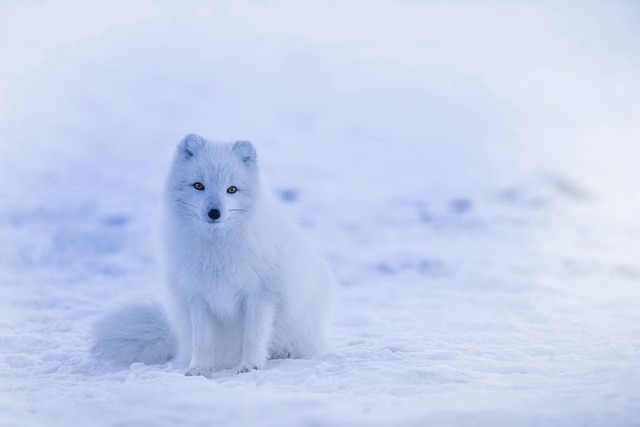
Finding Inspiration in the Winter Wonderland: Unleashing Creative Writing Prompts
Frosty imagery: crafting vivid descriptions in winter writing prompts, embracing solitude: exploring personal reflections through winter writing prompts, chasing the muse: nurturing creativity during the cozy winter months, nurturing creativity during the cozy winter months, captivating tales by the fireplace: using winter writing prompts for fiction, a brush with words: igniting poetry through winter writing prompts, journeying through the snow: using winter writing prompts for travel writing, unlocking memories: tapping into nostalgia with winter writing prompts, frequently asked questions, wrapping up.
As winter casts its enchanting spell across the land, it presents a myriad of captivating scenes that can serve as a wellspring of creativity for aspiring writers. From the snow-covered landscapes to the festive holiday spirit, the winter wonderland offers a plethora of opportunities to unleash your imagination and embark on a journey of expression through creative writing. To help kick-start your winter writing adventures, we’ve compiled a collection of unique prompts to inspire your creativity during this magical season.
1. Immerse yourself in the stillness of a snow-covered forest. Describe the crisp air and the icy silence that envelopes the landscape. Let your imagination guide your senses and paint a vivid picture of the serene scenery.
2. Recall a cherished holiday memory from your childhood. Describe the sights, sounds, and scents that filled the air during this special time. Dive into the details and bring to life the warmth and joy that radiated from those moments.
3. Imagine being a snowflake floating gently from the sky. Write a poetic piece exploring your journey from the fluffy clouds to the world below. Consider the sensations, thoughts, and emotions you might experience along this beautiful descent.
Let the winter wonderland be your muse. Embrace the magic of the season, and with pen in hand, bring your unique stories and ideas to life. Winter offers a treasure trove of inspiration, waiting to be discovered by those keen enough to seek it.
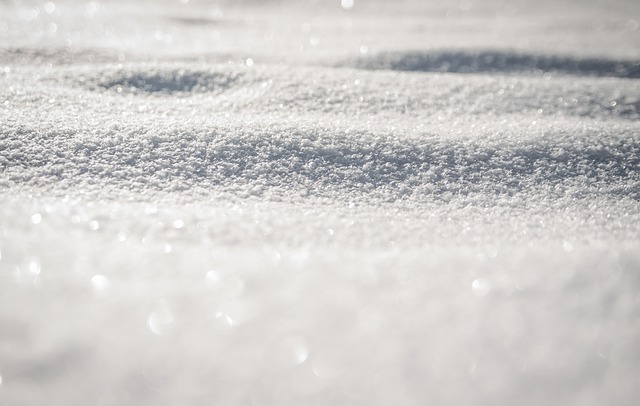
When it comes to winter writing prompts, one key element that can transform your piece is crafting vivid descriptions using frosty imagery. By incorporating sensory details and scenery, you can easily transport your readers into the wintry world you’ve created. Here are some tips to help you bring your winter writing to life:
- Tap into the senses: To truly immerse your readers in your winter setting, appeal to their senses. Describe the sharp, biting cold on their skin, the crunch of fresh snow under their boots, and the sound of distant sleigh bells.
- Paint a picturesque landscape: Create a winter wonderland by capturing the beauty of your surroundings. Depict the glistening frost on bare tree branches, the soft glow of moonlight reflecting off icy lakes, and the intricate patterns formed by snowflakes falling gently from the sky.
- Use vibrant language: Don’t shy away from using powerful adjectives and descriptive language that evokes a sense of coldness and serenity. Phrases such as “icy tendrils creeping along the windows,” “frost-kissed meadows stretching as far as the eye can see,” or “a frozen world painted in silver and blue” can bring your winter scenes to life.
By incorporating these techniques and experimenting with your own unique style, you can master the art of crafting vivid descriptions that will make your winter writing prompts come alive in the minds of your readers. Let your imagination soar and watch as your words create a wintery wonderland that leaves a lasting impression.

Winter offers a unique opportunity to delve into our inner thoughts and emotions as we find solace in the tranquility that this season brings. Through the gentle touch of snowflakes and the crispness of the air, we can tap into our creative selves and embark on a journey of personal reflection. One beautiful way to express our innermost musings is through writing. By engaging with winter writing prompts, we can unlock a world of self-discovery, allowing our thoughts to flow like a meandering river in the serenity of solitude. Winter writing prompts provide an outlet for introspection and self-expression, enabling us to explore a myriad of emotions and uncover profound insights about ourselves and the world around us.
As we put pen to paper or fingers to keyboard, we are transported into a realm where we can uncover hidden meanings and unearth dormant passions. Winter writing prompts encourage us to embrace the stillness, inspiring us to reflect on the beauty of nature, the significance of the changing seasons, and the impact of silence on our thoughts. These prompts can invite us to explore topics such as the cozy comforts of winter rituals, nostalgic memories of childhood snow days, or the lessons we can learn from the resilience of nature during harsh winters. They can also prompt us to reflect on personal growth, goals, and aspirations, encouraging us to envision the path we want to tread in the coming year. By immersing ourselves in winter writing prompts, we embark on an introspective journey that nurtures our soul, deepens our self-awareness, and empowers us to embrace the solitude that winter graciously provides.

As winter casts its chilly enchantment, artistically inclined individuals often find themselves longing for inspiration and ways to nurture their creativity while cocooned in warmth. The hibernation period offers a unique opportunity to embrace the cozy ambiance and indulge in activities that kindle the artist’s soul.
Here are some delightful suggestions to ignite your creative fire during the winter months:
- Embrace the joy of winter landscapes: Bundle up in layers, step outside, and let nature’s wintry beauty spark your imagination. Whether it’s a snowy forest, frozen lake, or cozy city streets adorned with twinkling lights, the winter world is a treasure trove of inspiration.
- Cultivate a cozy creative space: Designate a corner in your home where you can curl up with your favorite pen, paintbrush, or musical instrument. Surround yourself with blankets, scented candles, and soft lighting to foster a relaxing and imaginative atmosphere that invites creative flow.
- Explore new artistic endeavors: Winter provides the perfect opportunity to try your hand at different creative outlets. Experiment with painting, writing poetry, composing music, or even learning a new craft. Don’t be afraid to step outside of your comfort zone and discover hidden talents you never knew you had.
- Engage in reflective practices: Take advantage of the quiet introspective nature of winter. Engage in activities like journaling, meditation, or mindfulness exercises to delve deep within and connect with your creativity on a profound level. These introspective practices can help you tap into new ideas and unlock artistic pathways.
The cozy winter months can be a sanctuary for the creative soul, offering a respite from the busyness of the world and a chance to nurture your artistic side. Embrace the season’s charm, explore your creativity, and let the muse guide you on a magical journey through the wintertime wonders.
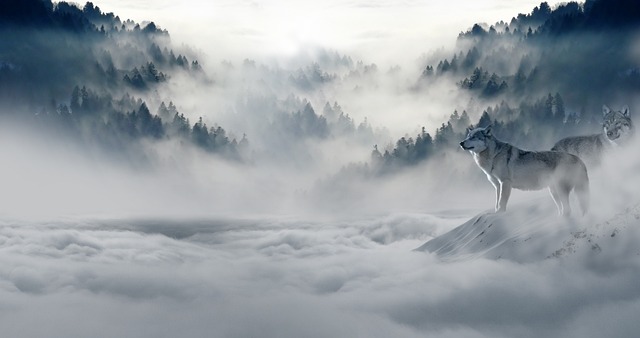
If you’re looking for inspiration to ignite your creativity during the winter season, look no further! Winter writing prompts can transport you to a cozy scene by the fireplace, where captivating tales come to life. So grab a mug of hot cocoa, wrap yourself in a warm blanket, and let these prompts guide you on a winter wonderland adventure in your fiction writing.
To start off, imagine a frosty forest where the trees seem to whisper ancient secrets in the wind. Here are a few winter writing prompts to get your imagination flowing:
- 1. Frozen in Time: Write a story about a mythical creature that only comes alive during the coldest days of winter.
- 2. Snow Globe Surprises: Describe a character who receives a magical snow globe that grants their deepest wishes, but at a hidden cost.
- 3. Winter Wonderland Adventure: Take your readers on a thrilling journey through a snowy landscape, where your protagonist overcomes obstacles to find a hidden treasure.
Now, let’s venture inside a cozy cabin, where a crackling fire casts a warm glow over everything. Here are a few more winter writing prompts to spark your storytelling:
- 1. The Gift of Family: Write a heartwarming tale about a family coming together to celebrate a holiday in the midst of a winter storm.
- 2. Winter’s Melody: Describe a musician who finds inspiration in the hushed sounds of falling snow, composing a hauntingly beautiful symphony.
- 3. Secrets in the Shadows: Create a mystery involving a group of friends snowed in at a cabin, with each harboring a secret that is slowly revealed as tensions rise.
So cozy up by the fireplace, let the winter writing prompts guide your imagination, and watch as your fiction writing transports your readers to captivating new worlds.
The winter season has a unique ability to spark creativity within us, and what better way to embrace this inspiration than through the art of poetry? Exploring the magic of words, “” is a remarkable avenue to dive into the depths of your imagination and bring forth emotive verses. With a collection of engaging prompts specially designed to invoke the essence of winter, this workshop will guide you towards creating captivating and heartfelt poetry.
During the workshop, you will have the opportunity to:
- Discover your poetic voice while embracing the winter atmosphere
- Engage in writing exercises specifically crafted to awaken your creativity
- Explore the themes of winter, from the stark beauty of snow-covered landscapes to the introspective warmth of fireside moments
- Receive valuable feedback and guidance from experienced poets
Don’t miss this chance to ignite your passion for poetry, as you immerse yourself in the enchanting world of winter through expressive verse. Join us at “” and let your emotions flow freely as you craft heartfelt poetry that captures the essence of this magical season.

When it comes to travel writing, the winter season offers a unique opportunity to explore the breathtaking beauty of snow-covered destinations. Whether you find yourself trekking through snowy mountains or strolling down charming wintry streets, capturing the essence of these experiences in your writing can transport your readers to these enchanting winter wonderlands. To help you spark your creativity and enhance your winter travel writing, we’ve compiled a list of engaging writing prompts that will inspire you to describe the magic of the season:
- Winter’s Grip: Describe the feeling of cold air biting against your cheeks and the satisfying crunch of snow beneath your boots. How does the sensation of winter change the way you perceive your surroundings?
- Mystical Landscapes: Dive into the ethereal beauty of winter landscapes. Write about the gentle embrace of snow-blanketed forests or the glittering icicles hanging from rooftops. How does the white canvas of winter transform the scenery?
- Festive Traditions: Explore the unique traditions and celebrations that accompany winter in different cultures. Share the warmth of holiday gatherings, the joy of ice skating on frozen lakes, or the enchantment of witnessing dazzling Christmas markets.
By delving into these prompts, you can elevate your travel writing and evoke the awe-inspiring imagery of winter destinations. Embrace the magic of winter through your words and take your readers on an unforgettable journey through snowy landscapes and cherished traditions. So, grab your pen and start crafting your winter travel tales, immersing your audience in the wonders that lie beyond the frosty windowpane.
As the winter season settles in, there’s something magical about the crisp air and cozy nights that evoke memories of times gone by. What better way to captivate those nostalgic feelings than through writing? Winter writing prompts serve as a key to unlock the floodgates of memories, allowing you to express yourself creatively and relive cherished moments. So, grab a mug of hot cocoa, cozy up by the fireplace, and let these prompts transport you to the wintery realms of your past.
1. Winter Wonderland: Describe a picture-perfect winter scene from your childhood. Bring to life the snow-covered trees, the sound of crunching footsteps, and the sense of wonder that enveloped your younger self. Explore the intricate details that made that winter moment so memorable.
2. Ice-skating Memories: Recall the first time you glided across a frozen pond or twirled in an ice-skating rink. Describe the exhilaration you felt as you moved effortlessly on ice, the cold wind on your face, and the joy of laughter that filled the air. Share any poignant or amusing anecdotes from your ice-skating adventures.
Q: What is “Winter Whispers: Igniting Winter Creative Writing Prompts” about? A: “Winter Whispers: Igniting Winter Creative Writing Prompts” is an article that aims to provide a variety of inspiring writing prompts specifically tailored for the winter season.
Q: Why are winter creative writing prompts important? A: Winter creative writing prompts serve as a valuable tool to ignite imagination and inspire individuals to express their thoughts and feelings through writing during the colder months. These prompts offer a unique opportunity to explore the season’s themes, landscapes, and emotions.
Q: How can winter creative writing prompts help someone improve their writing skills? A: Winter creative writing prompts offer a focused avenue for practicing and honing writing skills. By engaging with these prompts, individuals can enhance their ability to craft vivid descriptions, develop complex characters, and create compelling narratives.
Q: Are these creative writing prompts suitable for all ages? A: Absolutely! “Winter Whispers: Igniting Winter Creative Writing Prompts” provides a wide range of prompts that are suitable for writers of all ages, from young children to adults. Whether you’re a beginner or an experienced writer, there’s something for everyone in this article.
Q: Can these winter creative writing prompts be used for both fiction and non-fiction writing? A: Certainly! The prompts presented in “Winter Whispers: Igniting Winter Creative Writing Prompts” are versatile and can be applied to various genres of writing, including both fiction and non-fiction. They can be used to spark imaginative stories, personal essays, descriptive pieces, and more.
Q: How can these winter prompts help overcome writer’s block? A: Writer’s block can be a challenging obstacle, but “Winter Whispers: Igniting Winter Creative Writing Prompts” can help reignite creativity and overcome this hurdle. The article offers an array of prompts designed to inspire and engage writers, providing fresh ideas to get their creative juices flowing .
Q: Can these prompts be adapted for other seasons or specific holidays? A: While the focus of this article is on winter-themed prompts, many of these can certainly be adapted for other seasons or specific holidays. Feel free to draw inspiration from the provided prompts and tailor them to suit the occasion or season you’re interested in.
Q: How should one approach these winter creative writing prompts? A: Approach these prompts with an open mind and let your imagination take flight. Choose a prompt that resonates with you and allow it to guide your writing. Don’t worry about perfection—just let the words flow and enjoy the process of creating.
Q: Where can I find “Winter Whispers: Igniting Winter Creative Writing Prompts”? A: “Winter Whispers: Igniting Winter Creative Writing Prompts” can be found on our website or in the latest edition of our online magazine. Simply visit our website or subscribe to our newsletter to access this inspiring article and many more writing resources.
In conclusion, Winter Whispers offers a plethora of creative writing prompts that will spark your imagination and keep you inspired during the colder months.
Exploring Voices: Journal of Creative Writing Insights
Educating Through Words: What Type of Writing Educates Readers About a Topic?
Leave a Comment Cancel reply
Save my name, email, and website in this browser for the next time I comment.
Reach out to us for sponsorship opportunities.
Welcome to Creative Writing Prompts
At Creative Writing Prompts, we believe in the power of words to shape worlds. Our platform is a sanctuary for aspiring writers, seasoned wordsmiths, and everyone. Here, storytelling finds its home, and your creative journey begins its captivating voyage.
© 2024 Creativewriting-prompts.com
Start Writing
How to Write the Winter Season

Winter, a season of stark contrasts and sensory experiences. It provides the perfect canvas to paint vivid scenes that range from cosy romances to horror -filled stormy nights.
When writing about winter, it’s essential to capture the essence of its chill and the way it can transform the world. Here are some quick tips!
- A blanket of pristine snow covering the landscape
- Bare tree branches coated with frost
- Delicate snowflakes drifting from the grey sky
- Icicles hanging like crystal daggers from rooftops
- Colourful clothes stark against the white of snow
- Sunlight reflecting off the snow, creating a blinding glare
- Animal tracks stamped into the powder
- Frozen lakes and puddles
- Man-made objects like snowmen and snow angels
- Lights shining against dark backdrops
- Snow muffling and dampening the usual noises
- Boots crunching on the frozen ground
- People laughing and shouting as they play
- Wind howling through barren branches
- Ice cracking underfoot or on distant lakes
- The silence of a snow-covered world
- Shovels scraping against sidewalks
- Snowballs hitting their targets with soft thuds
- Branches creaking, laden with snow
- The rustle of animals keeping warm in burrows
- The fresh, clean scent of snow in the air
- Wood smoke curling from chimneys
- The earthy aroma of damp wool from coats and gloves
- The sharp tang of frost and cold metal
- Hot chocolate and marshmallows
- Pine needles and the subtle scent of evergreen
- Baking spices from holiday treats
- The slight ozone smell before a snowstorm
- Wet dog from snowball fights with furry friends
- Leather and polish from well-worn boots
- Building snow forts and castles
- Ice skating on a frozen pond or rink
- Snowshoeing through a silent forest
- Curling up by the fire with a good book
- Skiing and snowboarding down powdery slopes
- Brisk walks to enjoy the winter air
- Hiking up snowy mountains for panoramic views
- Having snowball fights with friends or family
- Feeding birds or wildlife braving the cold
- Decorating the home with festive lights and ornaments
Character body language
- Shivering and huddling for warmth
- Rubbing hands together or blowing on them for heat
- Shoulders hunched against the biting wind
- Slipping and steadying oneself on icy patches
- Squinting against the bright snow glare
- Snuggling into oversized coats and scarves
- Stamping feet to restore circulation
- Clapping hands to keep the cold at bay
- Arms wrapped around the torso for warmth
- Quick, brisk movements to minimise exposure to the cold
Positive descriptions
- The serene beauty of a snow-covered meadow at dawn
- The invigorating feeling of cold air filling your lungs
- The cosiness of a warm blanket on a frosty night
- The joy of catching snowflakes on your tongue
- The camaraderie of coming together to shovel snow
- The nostalgia of winter holidays and traditions
- The satisfaction of making the perfect snowball
- The wonder of ice patterns on windows
- The laughter and excitement of a snow day
- The glistening of a frosted evergreen in the sun
Negative descriptions
- The biting sting of the wind against exposed skin
- The numbness of fingers and toes in the cold
- The dreariness of shortened, grey days
- The inconvenience of navigating slushy streets
- The isolation of a blizzard keeping everyone indoors
- The discomfort of wet socks and snow in your boots
- The hazard of black ice on sidewalks and roads
- The burden of heavy layers and winter gear
- The dull ache of a cold that lingers
- The gloom that can accompany the lack of sunlight
Helpful adjectives
- Biting, chilly, frosty, glacial, icy
- Crisp, brisk, sharp, piercing, raw
- Fluffy, powdery, crunchy, slick, slippery
- Dreary, overcast, bleak, sombre, grey
- Cosy, snug, warm, toasty, plush
- Twinkling, sparkling, shimmering, glistening
- Silent, muffled, still, hushed, quiet
- Fresh, clean, invigorating, brisk, bracing
- Nostalgic, traditional, joyous, festive, celebratory
- Isolating, inconvenient, burdensome, hazardous, gloomy

Ready to achieve your writing goals? Join Novlr today.

IMAGES
VIDEO
COMMENTS
The winter is such crystalline joy, those brilliant rays that show the uniqueness of every snowflake. It is the time of puddles that become transient skating rinks and for my thoughts to remain cozy within a woollen hat.
What is the best way to start a description of the winter season in writing? How can I effectively convey the weather and temperature of winter in my writing? What are some key elements of the winter landscape to include in my description? How can I make my writing about winter more sensory-rich?
Winter writing prompts are creative cues that inspire stories, poems, and essays centered around the winter season. They serve as a starting point for writers to explore various aspects of winter, from the serene beauty of a snowy day to the excitement of winter sports.
Weather (sorry) or not you love the snow—blanketing your driveway, stalling your subway lines—it’s hard to deny that there have been some pretty darn good descriptions of it in literature, the kind that make you want to curl up by the fire (or, in my case, the space heater).
In this creative warm-up, we will explore the beauty of winter scenery through vivid descriptions. Get ready to sharpen your imagination and get inspired by the magical landscapes that winter has to offer.
Unleash Your Imagination with Captivating Winter Settings. Discover the Magic of Snow: Evoking Winter Wonderland in your Writing. Unwrapping Emotions: Explore the Intricacies of Winter Feelings. Embrace the Chill: Crafting Engaging Characters in Frozen Landscapes.
20 Winter Writing Prompts. 1. Write about a snowy winter evening spent curled up by the fire with loved ones. 2. Imagine a world covered in ice and snow, and describe what life would be like there. 3. Reflect on all of the things you love most about winter: the cozy sweaters, the steaming cups of hot chocolate, and more. 4.
“Winter Whispers: Igniting Winter Creative Writing Prompts” provides a wide range of prompts that are suitable for writers of all ages, from young children to adults. Whether you’re a beginner or an experienced writer, there’s something for everyone in this article.
Here are some quick tips! Sights. A blanket of pristine snow covering the landscape. Bare tree branches coated with frost. Delicate snowflakes drifting from the grey sky. Icicles hanging like crystal daggers from rooftops. Colourful clothes stark against the white of snow. Sunlight reflecting off the snow, creating a blinding glare.
Winter writing prompts can be a great way to get your creative juices flowing during the colder months. Whether you're reflecting on your favourite winter activities, imagining life as a snowflake, or crafting a winter narrative, there are plenty of ways to explore this season through writing.